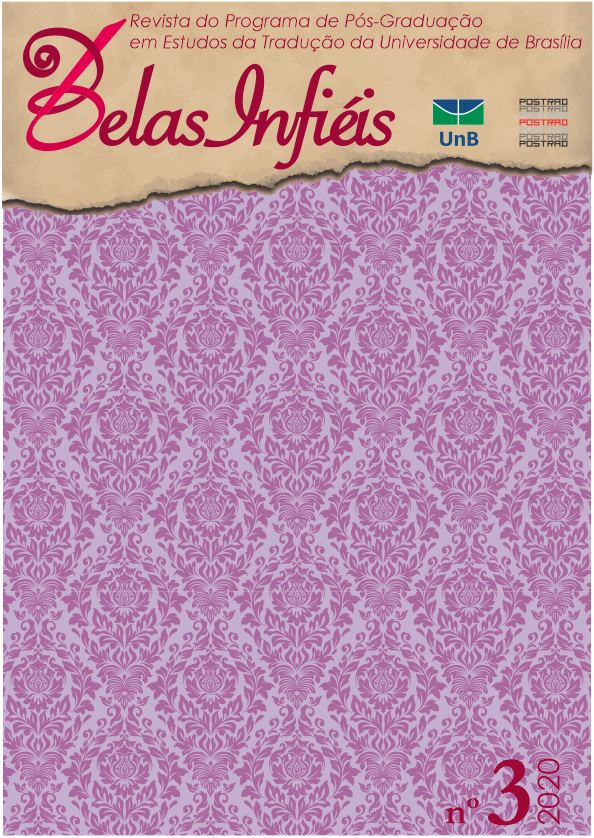Hermenêutica bíblica em antropônimos. Possibilidades “depois de Babel”
DOI:
https://doi.org/10.26512/belasinfieis.v9.n3.2020.30830Palavras-chave:
Tradutologia. Textologia. Hermenêutica bíblica. Antropônimos.Resumo
Muitas vezes (especialmente com o Antigo Testamento), antropônimos bíblicos podem ser descritos como nomes dinâmicos, pois contribuem para a construção do conteúdo de um texto e são elementos ativos no processo de transmissão desse significado para um espaço cultural ou tempo cultural diferentes. Consequentemente, o modo com o qual os tradutores da Bíblia lidam com eles, intencional ou acidentalmente, afetam as chances do leitor-alvo de captar a mensagem originalmente pretendida no texto. O presente trabalho segue os avatares dos nomes da filha de Jó (cf. Jó 42:14) do hebraico, ao grego e ao latim e, em seguida, aos vernáculos, como o romeno, e sugere que “embora igualmente explicáveis contextualmente e/ou pragmaticamente” diferentes opções de tradução atingem diferentes níveis de relevância, ou representatividade, em relação ao texto original e, de fato, às intenções tradutórias complexas e em múltiplos níveis.
Downloads
Referências
ADLER, C. et al. (Editorial Board). Jewish Encyclopaedia, 1901-1906. http://www.jewishencyclopedia.com/ .
Anthologie grecque. Première partie, Anthologie palatine. Tome X (Livre XI). Texte établi et traduit par Robert Aubreton, Paris: Société d’Édition « Les Belles Lettres », 1972.
BAILLY, A. Dictionnaire Greque-Français, Paris: Hachette, [s.a.].
BALLARD, M. Le nom propre en traduction, Gap, Paris: Ophrys, 2001.
BRÉAL, M. Semantics. Studies in the Science of Meaning (Translated by Henry Cust), New York, 1900.
BROWN, F. The Brown-Driver-Briggs Hebrew and English Lexicon. With an appendix containing the Biblical Aramaic, Oxford: Clarendon Press, 1907.
CORBEA, T. Dictiones latinae cum valachica interpretatione. Ediţie de Alin Mihai Gherman, Cluj, 2001.
WAARD, de, J., NIDA, E.A. From One Language to Another. Functional Equivalence in Bible Translating, Nashville: Thomas Nelson Publishers, [1986].
DLR. DicÅ£ionarul limbii române, Tomul I, Partea II, C, BucureÅŸti, 1940.
GAFFIOT, F. Dictionnaire latin-français, Paris: Hachette [s.a.].
GAFTON, A. Numele în Biblie, in AUI, IIIe. Lingvistică, t. LI, 2005, pp. 165-179.
GEERAERTS, D. Words and Other Wonders. Papers on Lexical and Semantic Topics, Berlin/New York: Mouton de Guyter, 2006.
HUMPHREY, C. “On Being Named and Not Named: Authority, Persons, and Their Names in Mongolia”. The Anthropology of Names and Naming, edited by Gabriele vom Bruck, Barbara Bodenhorn, Cambridge UP, 2006, pp. 158-176.
JOOSTEN, J. Sermon on Job, Holocaust Memorial Sunday, 2019, Oriel college, Oxford, 27 Jan. 2019. https://www.academia.edu/38903344/Sermon_on_Job_Holocaust_Memorial_Sunday_2019.
JOOSTEN, J. “Translating the Untranslatable: Septuagint Renderings of Hebrew Idioms”. Translation Is Required”: The Septuagint in Retrospect and Prospect, edited by R. Hiebert, Leiden: Brill / Atlanta: SBL, 2010. pp. 59-70.
LAYNE, L. “‘Your Child Deserves a Name’: Possessive Individualism and the Politics of Memory in Pregnancy Loss”. The Anthropology of Names and Naming, edited by Gabriele vom Bruck, Barbara Bodenhorn, Cambridge UP, 2006, pp. 31-50.
LIDDELL-SCOTT. A Greek-English Lexicon, Compiled by Henry George Liddell, Robert Scott, A New Edition Revised and Augmented throughout by Sir Henry Stuart Jones, Oxford, [s.a.].
LUNGU-BADEA, G. “Note cu privier la traducerea numelor proprii literare”. Studii de traductologie românească. I. Discurs traductiv, discurs metatraductiv, coord. Georgiana Lungu-Badea, Nadia Obrocea, TimiÈ™oara: Editura Universității de Vest, 2017, pp. 251-266.
PEIRCE, C.S. The Essential Peirce, vol. 2, Bloomington and Indinalopils: Indiana UP, 1998.
PLATO, “Symposium”. Plato in Twelve Volumes, Vol. 9. Translated by Harold N. Fowler. Cambridge: MA, Harvard University Press; London: William Heinemann Ltd. 1925.
ROSEN, M. Eseuri biblice, BucureÅŸti: Hasefer, 1992.
RYKEN, L. et al. Dictionary of Biblical Imagery (electronic ed.), Downers Grove, IL: InterVarsity Press.
Septuaginta 4/II. Septuaginta. Iov, ÎnÅ£elepciunea lui Solomon, ÎnÅ£elepciunea lui Sirah, Psalmii lui Solomon. Volum coordonat de: Cristian Bădiliţă, Francisca Băltăceanu, Monica BroÅŸteanu, [s.l.], Polirom, 2006.
STAMATI, T. DisionăraÅŸu românescu de cuvinte tehnice ÅŸi altele greu de înÅ£elesu, IaÅŸi, 1851.
STRONG. Strong’s Concordance. http://concordances.org/hebrew/1126.htm
SWANSON, J. Dictionary of Biblical Languages with Semantic Domains: Hebrew (Old Testament) (electronic ed.). Oak Harbor: Logos Research Systems, Inc., 1997.
TDRG2. TIKTIN, H. Rumänisch-Deutsches Wörterbuch, ed. a II-a, überarbeitete und ergänzte Auflage von Paul Miron, Band I-III, Wiesbaden: Otto Harrassoowitz, 1986, 1988, 1989.
Testamentul lui Iov, in Trei apocrife ale Vechiului Testament: Iosif ÅŸi Aseneth, Testamentul lui Iov, Testamentul lui Avraam, IaÅŸi, Polirom, 2000.
THAYER. A Greek-English Lexicon of the New Testament Being Grimm’s Wilke’s Clavis Novi Testamenti, Translated, Revised and Enlarged by Joseph Henry Thayer, D.D., 1889.
TRASK, R.L. Language and Linguistics. The Key Concepts, Routledge, 2007.
Downloads
Publicado
Como Citar
Edição
Seção
Licença
Copyright (c) 2020 Belas Infiéis

Este trabalho está licenciado sob uma licença Creative Commons Attribution 4.0 International License.
Dado ao acesso público desta revista, os textos são de uso gratuito, com obrigatoriedade de reconhecimento da autoria original e da publicação inicial nesta revista
A revista permitirá o uso dos trabalhos publicados para fins não comerciais, incluindo direito de enviar o trabalho para bases de dados de acesso público. As contribuições publicadas são de total e exclusiva responsabilidade dos autores.
Os autores, ao submeterem trabalhos para serem avaliados pela revista Belas Infiéis, mantêm os direitos autorais e concedem à revista o direito de primeira publicação, sendo o trabalho licenciado sob a Creative Commons Attribution License Atribuição 4.0 Internacional (CC BY 4.0).



















